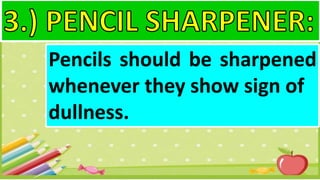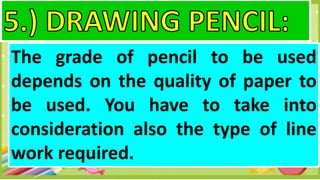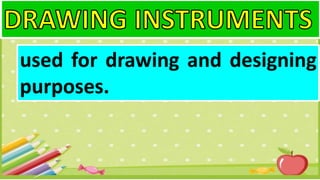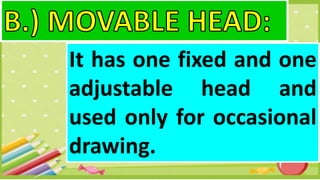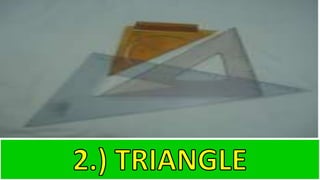(2) Drafting Materials and Tools by Mary Krystle Dawn D. Sulleza
- 1. DRAFTING MATERIALS AND TOOLS, ITS USES/ FUNCTIONS
- 2. Various types of drawing papers are available for use but hard and soft surface drawing papers are highly recommended to be the best.
- 3. This type does not groove easily when pressure is applied to the pencil. Oslo paper is commonly used but bond paper is also recommended.
- 5. used for fastening the drawing paper on the drawing table or drawing board because it does not damage the board and it will not damage the paper if it is removed by pulling it off.
- 7. Pencils should be sharpened whenever they show sign of dullness.
- 9. used to clean the dirt off the drawing.
- 11. one of the most important tools in drawing. It comes in various grades.
- 12. The grade of pencil to be used depends on the quality of paper to be used. You have to take into consideration also the type of line work required.
- 13. are used where extreme accuracy is required especially working on graphs, diagrams and charts.
- 15. used for general purpose work in drawing.
- 17. are too soft to be used in mechanical drafting. They are very useful for art work of various kinds.
- 19. This is a tool generally used when reproducing a drawing in an enlarged or reduced form to some regular proportion.
- 21. This tool is made up of metal with irregular holes. It is a useful tool to protect the rest of the drawing when clearing up smudges, unnecessary pencil lines and other erasures
- 24. used for drawing and designing purposes.
- 25. used when making horizontal lines. It is also used for guiding triangles when drawing vertical lines.
- 28. The head is fastened to the blade. It is used for ordinary work.
- 29. It has one fixed and one adjustable head and used only for occasional drawing.
- 30. It is designed for comfort when carrying the T-square.
- 31. It is a three-sided ruler, which typically has two equal sides meeting at a 90 degree angle and to a third side at 45, 30, including 60 degree angles.
- 32. It is usually made of plastic and comes in different sizes. If in use, the base of the triangle must rest on the blade of the T-square. Drawing a line always starts from the point near the base going upward.
- 34. 1.) 30 degrees x 60 degrees 2.) 45 degrees x 45 degrees
- 35. used when drawing arcs and circles. It is used in a similar way to a divider
- 37. used when transferring measurements, dividing lines and arcs into the desired number of equal parts.
- 39. It is a semi-circular instrument divided into 180 equal parts, each of which is called a degree. It is used to determine gradations of the degrees when measuring arcs, angles and circles.






